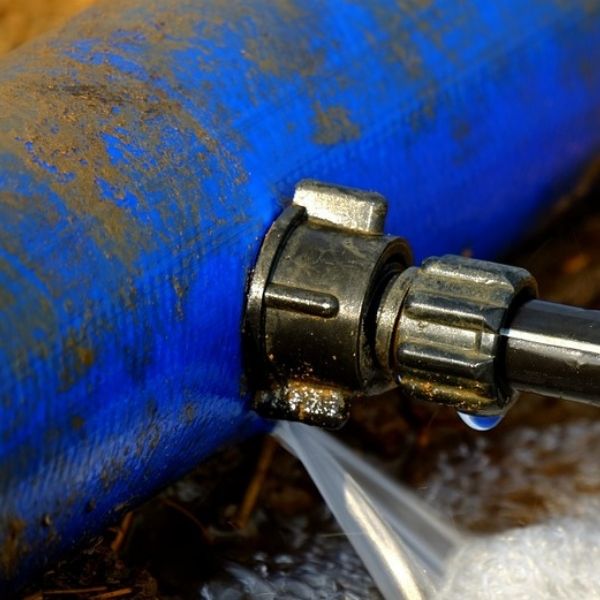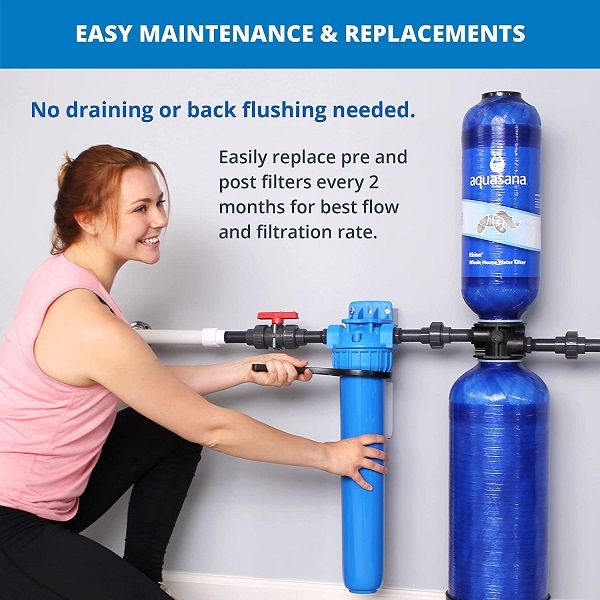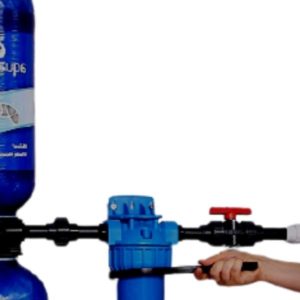What to Check First When the Water Softener Is Leaking?
Before you jump in and start doing the handy work, it is essential to check some necessary tasks off.
You do this to ensure that you do not hurt yourself in the process or cause further damage.
The first step is to disconnect the power supply attached to the water softener. Disconnect it right from the circuit breaker, so you remove the chance of any shocks.
The next thing to deal with is the water supply of your leaking water softener. You do this by turning the water softener bypass valve in the opposite direction.
The bypass valve can be located in different places on different models. Sometimes it is at the top rear, sometimes there are two knobs on top of the valve, and sometimes the bypass valve can be on either side of the head.
For each of these cases, the user manual will contain the details on how to work on them. Once you’ve turned them, you bypass the water supply of your water softener.
Do know that any water that reaches your appliances will be hard because you have deactivated your softener after this.
Some water softeners will not have a bypass valve; you will have to shut off the water supply line’s valve directly.
After you are done with these two steps, you can easily work on the leak, and you will not have any disruptions.

Reasons Why My Water Softener Is Leaking and How to Fix Them
Now that you have ensured your safety, you can explore the different scenarios that might be the cause of your water softener leaks.
Some of these issues will be small enough for you to fix on your own easily. And yet, for some others, you will need to call a professional plumber who can help you out.
Water softener cracked rotor valve.
The rotor valve is usually placed at the top of your water softener and is the part from where the water enters the unit.
Because of its frequent use, this part can often start leaking because of the crack that is developed.
Often, no cracks are visible on the rotor valve, but water is still leaking from the top. This means that the seal inside the rotor valve could be the one that is affected.
In any case, call a plumber as soon as possible to fix this problem.
Water softener punctured brine tank.
A water softener functions by replacing calcium and magnesium ions in your hard water with sodium ions. The sodium is present inside a brine tank located within the softener.
If your water softener brine tank has a puncture in it, it is better to replace the entire brine tank.
Because here’s the thing, you could pick up certain sealants, and they might even work in specific cases. But any chance that you pick and fix the wrong one, your water softener will get gravely damaged.
To prevent that from happening, it is better to remove the punctured brine tank altogether.
Water softener hose connection leakage
This is a relatively simple one. If you notice your water softener hose leaking, it might be a problem with a loose hose connection.
The first thing you do is try and tighten the water softener hose. If that does not work, the problem could be a little more serious.
It is possible that the hose has been punctured, in which case, you will need to replace it with a new one.
Problems with the o rings in the bypass valve
The bypass valve is usually placed there for our convenience to quickly cut off the water flow to the softener and not your entire house.
But the leak can often start from this point as well. Even if you do not see the water yourself, mineral buildup around the area can be a good sign.
The bypass valve has a component called the o-rings. These o-rings get older and wear off with time.
If we do not maintain them properly, they will eventually need to be replaced. A defect in the o-rings can also lead to a water softener leak.
This is why it is essential to take care of your o-rings and replace them within the appropriate time.
Sometimes your water softener will have a kit that can be used to fix your bypass mode valve. If worst goes to worst, you will have to get a new bypass valve.

Water softener resin tank leakage
Check to see if you can find any cracks on the resin tank itself or any of the connection lines around it.
If the tank is cracked, you should check your warranty and contact the company for a replacement if the warranty still holds.
If the warranty has expired, do not worry, you can do a minor procedure to attempt to fix the leak.
Turn off your water softener system, clean the tank, and use waterproof solid epoxy to seal the cracks.
If the leak is in the connection to the resin tank, try tightening it and checking if the o-rings need a replacement.
Water softener leaking from the drain line
Over time, your water softener drain line can crack or burst or even get blocked, and sometimes, it is not correctly installed to begin with.
First, check for an air gap that may exist in case the line is installed improperly.
Once you rule that out, you move towards checking for cracks. Follow down the drain line to search for damages.
You can check if any blockage within the drain line caused the crack. Even better is to replace the drain line altogether. Instead of having a defective drain line and risking faulty plumbing, it is better just to get a new one.
Water softener leaking overflow
A water softener leak can sometimes occur because of an overflow. To solve this leaking issue, you need to understand why the overflow is happening.
A stuck brine tank float valve can be one of the reasons. The tank will overflow because the valve does not know when to stop. The solution is to replace the valve entirely.
The next thing is to check the brine line and ensure that it is properly connected with the tank float.
Remove any obstacles or blockages that you might find in any of the pipes, lines, or valves.
The problem can be with the water softener drain piping as well.
Check the drainline and make sure it is not blocking the brine line. If this happens, this can also cause an overflow.
Whatever the cause is, an overflow is a problem because not only is it an inconvenience, it tends to waste a lot of money. This will significantly enhance your water bill and will be bad for the environment as well.
Water softener leaking from the top
If you just see a water leak from the top, you might get confused about why it is happening. Most leaks from the top of a water softener happen due to two reasons.
It could be that a cracked rotor valve is causing the problem since the rotor valve is present at the top. You can try doing it yourself, but in order to prevent any issues, it is better to call a plumber.
The problem could be with the o-rings. It is essential that you have scheduled maintenance days dedicated explicitly to these rings.
Proper lubrication can keep them going for a long time, but if you neglect this and the rings are not lubricated frequently, they can be worn out even before their life cycle ends.
Replacement of the o-rings is a relatively easy task that you can finish yourself, just ensure you have the correct information regarding which rings you need to get.
If you are confused about any part, please make sure to call a water softener repair expert to get the relevant information.
An overflow can also cause a water softener to leak from the top. We have already discussed the relevant procedures to check and fix this problem, so make sure you are doing all that.
Water softener leaking from the bottom
If you see your water softener leaking from the bottom, it is usually a problem with either the brine tank or the resin tank.
They can crack, get punctured, or suffer from other forms of blockages. All of these issues can cause a massive hassle if they are not dealt with timely.
All problems concerning a water softener are supposed to be solved on time, but the ones related to the tank are even more essential. This is because of the importance of these components.
Lastly, whenever you find replacement parts, just make sure to look for the original brand.
Now that you know the different reasons that lead to a water softener leaking, we will look at the costs of fixing these problems.
How Much Does It Cost to Fix a Leaking Water Softener?
Obviously, one of the biggest concerns people have is the cost of fixing a leaking water softener. This is because you will have to pay this extra money above the already-paid water softener cost. This mainly depends on two factors.
Type of repair
The cost depends on the part which requires replacement. If you want to replace the rings, it will just take a few bucks, but if you’re going to replace the tank, the value will go up to hundreds of dollars.
Who does the repair?
If you fix things yourself, it will probably cost you less but take more of your time. On the other hand, hiring a professional will cost more but will save time for you.
So this decision depends on your priorities, and you have to decide for yourself.

Wrap-up
While some of the leaking problems your water softener has can be dealt with by yourself, it is better if you call a professional. This will ensure that no further issues occur.
Lastly, do not worry because even the best water softening system can often have issues.
